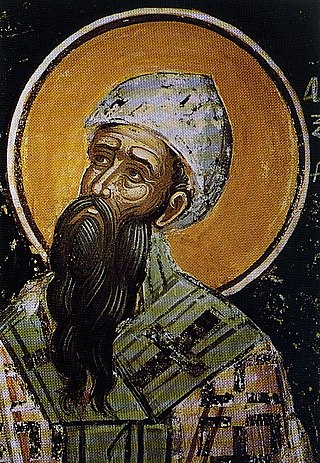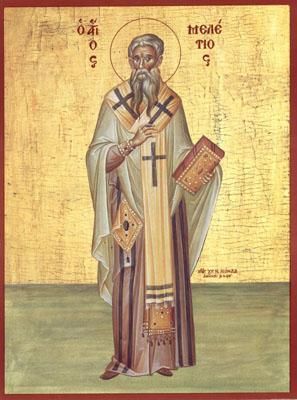
Cyril of Alexandria was the Patriarch of Alexandria from 412 to 444. He was enthroned when the city was at the height of its influence and power within the Roman Empire. Cyril wrote extensively and was a major player in the Christological controversies of the late-4th and 5th centuries. He was a central figure in the Council of Ephesus in 431, which led to the deposition of Nestorius as Patriarch of Constantinople. Cyril is counted among the Church Fathers and also as a Doctor of the Church, and his reputation within the Christian world has resulted in his titles Pillar of Faith and Seal of all the Fathers. The Nestorian bishops at their synod at the Council of Ephesus declared him a heretic, labelling him as a "monster, born and educated for the destruction of the church."
Epiphanius was the Ecumenical Patriarch of Constantinople from February 25, 520 to June 5, 535, succeeding John II Cappadocia.

Saint Meletius was a Christian bishop of Antioch from 360 until his death in 381. He was opposed by a rival bishop named Paulinus and his episcopate was dominated by the schism, usually called the Meletian schism. As a result, he was exiled from Antioch in 361–362, 365–366 and 371–378. One of his last acts was to preside over the First Council of Constantinople in 381.
Acacius was the Ecumenical Patriarch of Constantinople from 472 to 489. Acacius was practically the first prelate throughout Eastern Orthodoxy and renowned for ambitious participation in the Chalcedonian controversy.
Arsacius was the intruding archbishop of Constantinople from 404 to 405, after the violent expulsion of John Chrysostom. His memory is kept on 11 October.
Atticus was the archbishop of Constantinople, succeeding Arsacius of Tarsus in March 406. He had been an opponent of John Chrysostom and helped Arsacius of Tarsus depose him, but later became a supporter of him after his death. He rebuilt the small church that was located on the site of the later Hagia Sophia, and was an opponent of the Pelagians, which helped increase his popularity among the citizens of Constantinople.
Maximianus was the archbishop of Constantinople from 25 October 431 until his death on 12 April 434.
Euphemius of Constantinople was Ecumenical Patriarch of Constantinople (490–496). Theophanes calls him Euthymius. Prior to his appointment, Euphemius was a presbyter of Constantinople, administrator of a hospital for the poor at Neapolis, unsuspected of any Eutychian leanings, and is described as learned and very virtuous.

Severus the Great of Antioch, also known as Severus of Gaza or Crown of Syrians, was the Patriarch of Antioch, and head of the Syriac Orthodox Church, from 512 until his death in 538. He is venerated as a saint in the Oriental Orthodox Church, and his feast day is 8 February.

Epiphanius of Salamis was the bishop of Salamis, Cyprus, at the end of the 4th century. He is considered a saint and a Church Father by both the Eastern Orthodox and Catholic Churches. He gained a reputation as a strong defender of orthodoxy. He is best known for composing the Panarion, a very large compendium of the heresies up to his own time, full of quotations that are often the only surviving fragments of suppressed texts. According to Ernst Kitzinger, he "seems to have been the first cleric to have taken up the matter of Christian religious images as a major issue", and there has been much controversy over how many of the quotations attributed to him by the Byzantine Iconoclasts were actually by him. Regardless of this he was clearly strongly against some contemporary uses of images in the church.
Theophilus was the 23rd Pope of Alexandria and Patriarch of the Seat of Saint Mark. He became pope at a time of conflict between the newly dominant Christians and the pagan establishment in Alexandria, each of which was supported by a segment of the Alexandrian populace.
Acacius of Beroea, a Syrian, lived in a monastery near Antioch, and, for his active defense of the Church against Arianism, was made Bishop of Berroea in 378 AD, by Eusebius of Samosata.
The Patrologia Graeca is an edited collection of writings by the Christian Church Fathers and various secular writers, in the Greek language. It consists of 161 volumes produced in 1857–1866 by J. P. Migne's Imprimerie Catholique, Paris.
John II was bishop of Jerusalem from AD 387 to AD 417. John II succeeded to the episcopal throne of Jerusalem on the death of Cyril in 386. He was the author, according to an increasing number of modern scholars, of the five Mystagogical Catecheses traditionally ascribed to his predecessor Cyril.
Severian, Bishop of Gabala in Syria, was a popular preacher in Constantinople from around 398/399 until 404. He became the enemy of John Chrysostom and helped condemn him at the Synod of the Oak.
The Tall Brothers were four brothers among the Egyptian monks of Nitria in the fifth century by the names of Ammonius, Dioscorus, Eusebius, and Euthymius. They were referred to as the "Tall Brothers" because they were tall in stature and commanding in appearance.
Porphyrus of Antioch was a Patriarch of Antioch. He succeeded Flavian I in 404 and died in 412 to be replaced by Patriarch Alexander.

The Origenist crises or Origenist controversies are two major theological controversies in early Christianity involving the teachings of followers of the third-century Alexandrian theologian Origen.
Eustochius of Jerusalem was the patriarch of Jerusalem from 552 to 564. He was patriarch during the time of the Christological disputes during the reign of emperor Justinian.





